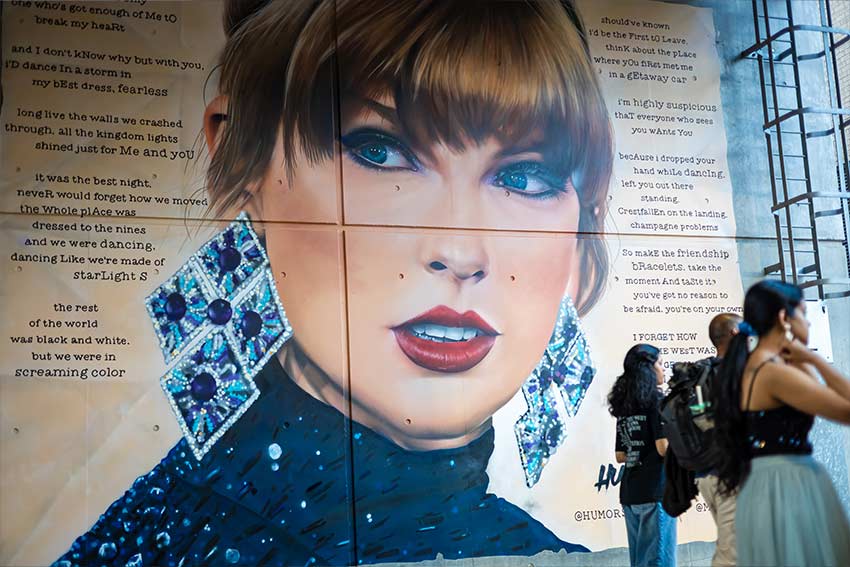Swift book fills research ‘blank space’

Edited by Dr Hannah McCann, Dr Emma Whatman and Dr Eloise Faichney, University of Melbourne; and Dr Rebecca Trelease, Auckland University of Technology, Taylor Swift: Culture, Capital, and Critique, sees experts across a wide range of academic fields turn their attention to all things Taylor Swift. From looking at how being part of Swift’s fandom helps fans gain skills for other areas of their life, to Swift’s inspiration for drag persona Taylor Sheesh in the Philippines, to whether Swift’s lyrics suggest she endorses the use of public transport, this book covers it all.
In academic settings, like universities, scholars are trained to hone their focus over many years, engaging in niche discussions with other experts who often share similar disciplinary methods and perspectives.
But what happens when the focus of analysis resists such containment – when it is not discipline-specific, but a global cultural phenomenon that demands interdisciplinary attention?
Though the vision of the contemporary university is one where interdisciplinary work and collaboration flourish, rarely do academics genuinely get the opportunity to mix between distinctive areas like law, psychology, cultural studies, urban studies, and more, with a shared interest.
Enter Swift studies, where singer-songwriter Taylor Swift is the centre of scholarly attention.
Swift’s star power is currently high.
With a nearly two-decade career and a global fandom estimated at over 500 million people worldwide, she has become a household name.
A 2023 survey found that more than half of all Americans consider themselves ‘Swifties’.
Despite being an extremely well-known celebrity, it is only very recently that Swift has garnered academic attention, with interest surging during the Eras Tour of 2023–2024, which sold over $US2billion in tickets.
At the time of writing, it became the highest-grossing tour of all time, double that of any other to date.
Her star power, fan-base and general mainstream popularity have become too big for academia to ignore.
Though the Eras Tour only visited select countries – most in Europe and North America – significant fandoms have arisen across the globe, in Anglophone and non-Anglophone countries alike.
Swift’s star reach is decidedly global, with her impact in various regions not just in terms of popular music and fandom, but also – perhaps unexpectedly – social, political and economic ramifications.
We might wonder, why has academia been so slow to engage with Swift until recently?
In part, Swift’s alignment with pop culture, femininity and mass appeal has rendered her vulnerable to biases that traditionally exclude such figures from serious scholarly enquiry.
However, as Swift’s global reach and social resonance have expanded, universities around the world have started to realise the potential, offering Swift-focused courses, spanning disciplines from gender studies, economics, popular music studies, communication industries, entrepreneurship, marketing, history, literature, psychology, creative writing and more.
Swift academia reflects not just an interest in Swift, but in the analytical possibilities she opens up, as she can provide a scaffolding for people’s entry ‘in’ to various areas of scholarship.
Importantly, Swift studies is not just about translating academic knowledge through Swift for a broad audience, but it is also about bringing a significant cultural phenomenon from the popular sphere into the academy and taking it seriously.
The rise of Swift studies is one move against the biases against low culture/pop culture/femininity that dominate academia.
As much as Swift has provided a voice on various social issues, there are many feminist, queer, critical race and other critiques of Swift’s body of work that need to be aired.
In this way, Swift is not clearly or easily a ‘hero’, so much as an ‘anti-hero’ – as she has identified in her music. Swift is a figure that can do wrong, and this needs to be attended to.
These insights are largely not about ‘Taylor Swift’ the person, but about Swift the cultural phenomenon – constructed and mediated through fandom, media industries and collective imaginaries.
The developing area of Swift studies reveals to us that Swift is both central to the field and yet most of the key takeaways are not exclusively about Swift. In other words, at this moment in time, Swift provides an expansive lens through which to see the world.
What’s clear is that Swift has monumental resonance across cultures and disciplines.
While there is a current flourish of academic interest in Swift, it is important that the insights gained from this area of study are maintained and built upon going forward.
This is an edited extract of Taylor Swift: Culture, Capital, and Critique – edited by Dr Hannah McCann, Dr Emma Whatman and Dr Eloise Faichney, University of Melbourne; and Dr Rebecca Trelease, Auckland University of Technology. The book is published by Routledge. It’s available to buy online.
Republished with permission from Pursuit. https://pursuit.unimelb.edu.au/articles/Taylor-swift-is-filling-a-blank-space-in-academic-research